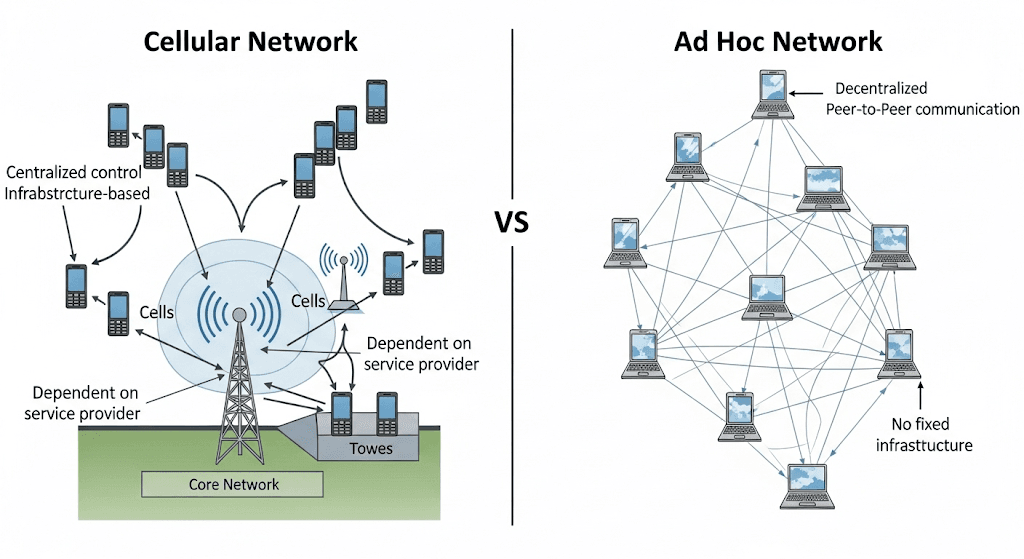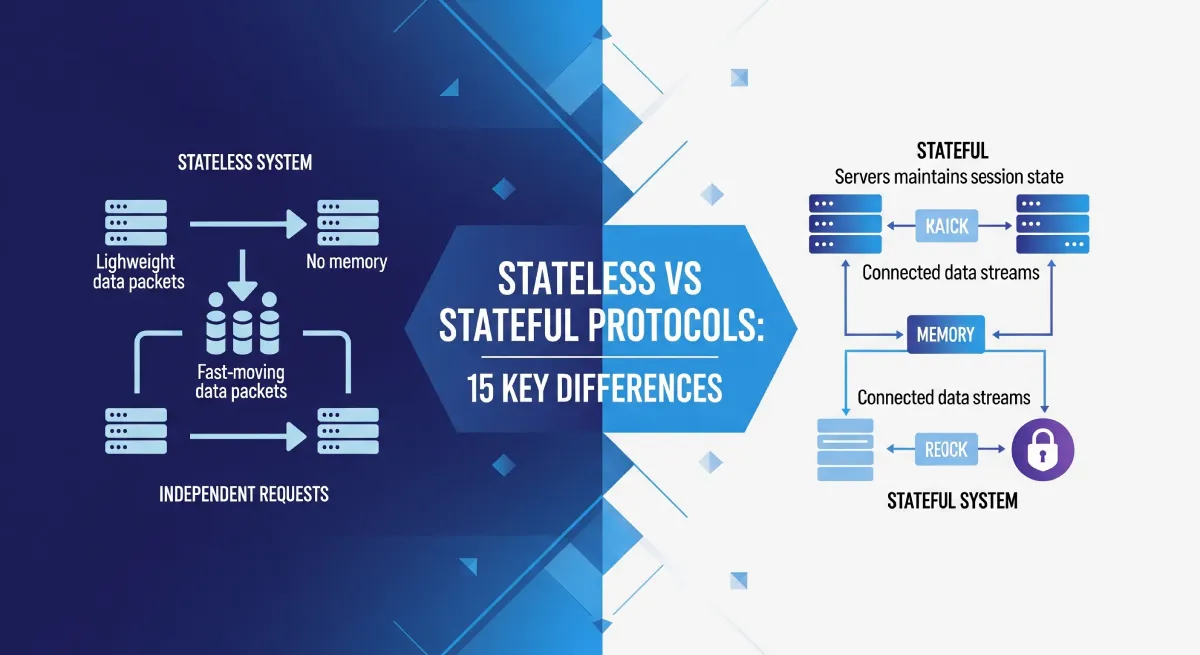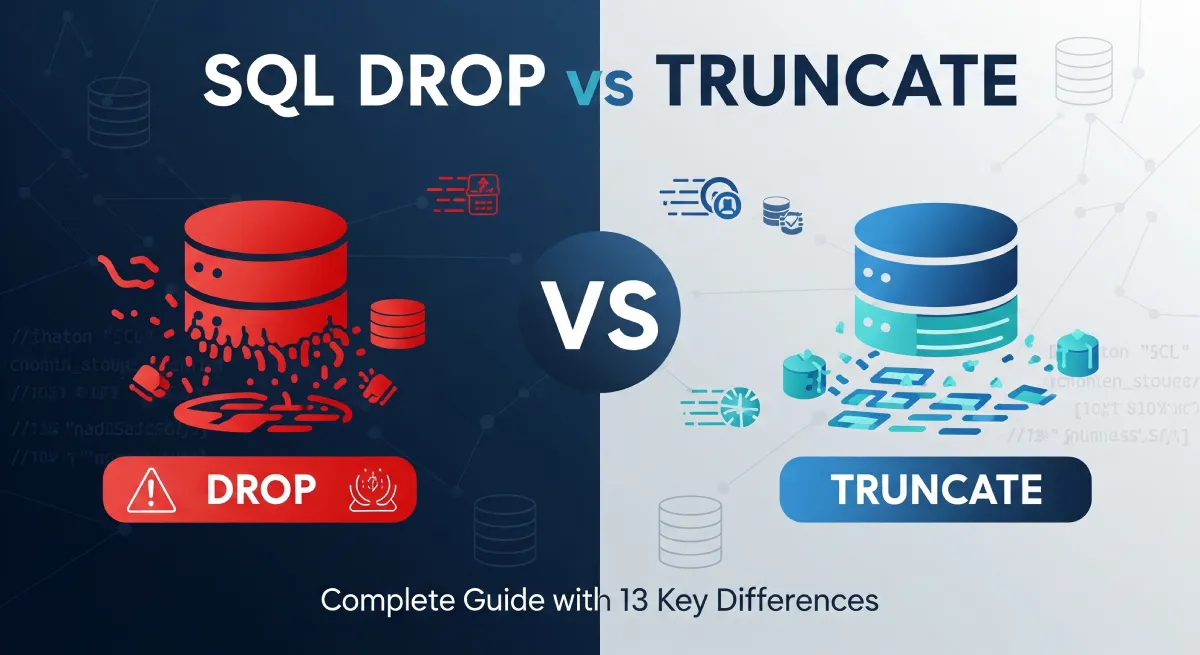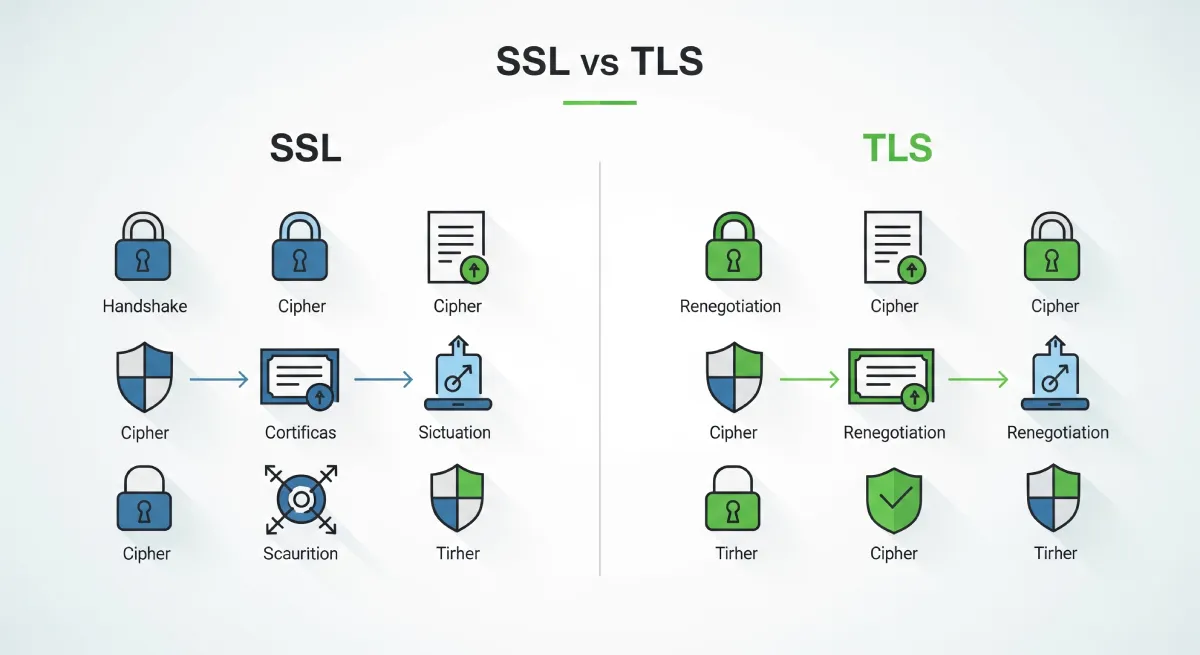
Table of Contents
What is a Cellular Network?
A cellular network is a communication system where a large geographic area is divided into smaller regions called cells. Each cell is served by a base station, which enables mobile devices to communicate with one another via radio waves. Cellular networks rely on fixed infrastructure and are typically used for mobile phone services, offering wide coverage and reliable connectivity.
Advantages and Disadvantages
Cellular Network Advantages
- Widespread coverage and reliable connectivity
- High-quality voice and data services
- Professional network management and maintenance
- Scalable to millions of users
- Standardized protocols ensure interoperability
- Quality of Service (QoS) guarantees
Cellular Network Disadvantages
- High infrastructure costs
- Dependent on fixed infrastructure
- Slow deployment in remote areas
- Single point of failure risk
- Limited flexibility for temporary deployments
Key Components of Cellular Networks
- Base Stations: Fixed transmitters that provide coverage to specific geographic areas
- Mobile Switching Centers (MSC): Control centers that manage call routing and handoffs
- Core Network: Backbone infrastructure connecting to the internet and other networks
- Mobile Devices: End-user equipment like smartphones and tablets
What is an Ad Hoc Network?
An ad hoc network is a decentralized wireless network where devices communicate directly with each other without relying on a fixed infrastructure. Each device acts as both a client and a router, forwarding data to other devices. Ad hoc networks are dynamic and temporary, commonly used in situations where setting up permanent infrastructure is not feasible, such as in emergency or military applications.
Advantages and Disadvantages
Ad Hoc Network Advantages
- Rapid deployment without infrastructure
- Self-organizing and self-healing capabilities
- Cost-effective for temporary applications
- Flexible and adaptable to changing conditions
- No dependency on centralized infrastructure
- Suitable for emergency and disaster scenarios
Ad Hoc Network Disadvantages
- Limited coverage and irregular connectivity
- Higher power consumption on mobile devices
- Security challenges due to distributed nature
- Complex routing and bandwidth management
- Performance degradation with network size
Types of Ad Hoc Networks
- Mobile Ad Hoc Networks (MANETs): Networks of mobile devices that can move freely
- Wireless Sensor Networks (WSNs): Networks of sensors collecting and transmitting data
- Vehicular Ad Hoc Networks (VANETs): Networks formed by vehicles for traffic management
- Flying Ad Hoc Networks (FANETs): Networks of drones or aircraft
Key Differences Between Cellular Network and Ad Hoc Network

Cellular Network | Ad Hoc Network |
|---|---|
| There is a fixed Infrastructure. | No fixed Infrastructure. |
| Circuit Switching is used. | Packet Switching is used. |
| Slow Deployment. | Very Rapid Deployment. |
| Single hop type. | Single and Multi-hop type. |
| Star Topology is used. | Mesh Topology is used. |
| Centralized, all the traffic goes through the Base Station. | Distributed, No centralized system such as Base station needed. |
| Stable Connectivity. | Irregular Connectivity. |
| Easier to employ bandwidth reservation. | Complex to employ bandwidth reservation. |
| Designed and developed for voice traffic. Guaranteed bandwidth. | Designed to meet the best-effort data traffic requirements. Shared Radio Channel. |
| Reuse of frequency spectrum through geographical channel reuse. | Dynamic frequency reuse based on carrier sense mechanism. |
| The high cost of network maintenance. | Self-organization and maintenance properties are built into the network. |
| The terminal nodes access the infrastructure via wireless links/nonwireless links. | The links are mostly wireless. An end-to-end connection can be made through multiple links. |
| Large Setup Time. | Less Setup Time. |
Detailed Architecture Comparison
Network Architecture
Cellular networks are structured around a central infrastructure, including base stations and a core network that connects users to the internet or other services. In contrast, ad hoc networks have no centralized control or fixed infrastructure. Instead, devices form the network spontaneously and rely on one another for data transmission, making the network more flexible but potentially less reliable than cellular systems.
Communication Protocols
Cellular networks use standardized protocols like GSM, CDMA, LTE, and 5G, which are designed for wide-area coverage and high-capacity communication. Ad hoc networks typically use protocols like AODV (Ad hoc On-Demand Distance Vector), DSR (Dynamic Source Routing), and OLSR (Optimized Link State Routing) that are optimized for dynamic, multi-hop communication.
Signal Coverage and Range
Cellular networks provide extensive coverage through strategically placed base stations, often covering entire cities or regions. Ad hoc networks have limited range based on the transmission power of individual devices, typically covering smaller areas but can extend coverage through multi-hop communication.
Real-World Applications
Cellular Network Applications
- Mobile Communication: Smartphones, tablets, and mobile internet
- Internet of Things (IoT): Smart city infrastructure, connected vehicles
- Emergency Services: 911 calls, first responder communication
- Business Communications: Corporate mobile networks, remote work connectivity
- Entertainment: Video streaming, mobile gaming, social media
Ad Hoc Network Applications
- Military Operations: Battlefield communication, tactical networks
- Disaster Response: Emergency communication when infrastructure is damaged
- Environmental Monitoring: Sensor networks for climate and wildlife tracking
- Smart Transportation: Vehicle-to-vehicle communication for traffic optimization
- Conference Networks: Temporary networks for events and meetings
How to Choose the Right Network Type
Consider Cellular Networks When:
- You need wide-area coverage and reliability
- Budget allows for infrastructure investment
- Long-term, permanent connectivity is required
- High-quality voice and data services are essential
- Network will serve a large number of users
Consider Ad Hoc Networks When:
- Infrastructure is unavailable or impractical
- Temporary or emergency communication is needed
- Budget constraints limit infrastructure investment
- Network needs to be deployed quickly
- Self-organizing capabilities are valuable
Future Trends and Technologies
Emerging Cellular Technologies
The evolution of cellular networks continues with 5G and beyond, offering ultra-low latency, massive connectivity, and enhanced mobile broadband. Future developments include 6G research, satellite integration, and network slicing capabilities that will further improve performance and flexibility.
Ad Hoc Network Evolution
Ad hoc networks are advancing with artificial intelligence integration, improved routing algorithms, and better energy efficiency. The rise of edge computing and IoT devices is creating new opportunities for ad hoc network applications in smart cities and autonomous systems.
Hybrid Network Solutions
The future may see increased integration between cellular and ad hoc networks, creating hybrid solutions that combine the reliability of cellular infrastructure with the flexibility of ad hoc networking. This could enable seamless connectivity in various scenarios.
Frequently Asked Questions
1. What is a Cellular Network?
A cellular network divides a large geographic area into smaller sections called cells. Each cell has a dedicated base station that allows mobile devices to communicate through radio waves. These networks depend on fixed infrastructure and primarily support mobile phone services, delivering broad coverage and consistent connectivity.
2. What defines an Ad Hoc Network?
An ad hoc network is a decentralized wireless network where devices communicate directly with each other without relying on a fixed infrastructure. Each device acts as both a client and a router, forwarding data to other devices. Ad hoc networks are dynamic and temporary, commonly used in situations where setting up permanent infrastructure is not feasible, such as in emergency or military applications.
3. How do the network structures of Cellular and Ad Hoc Networks differ?
Cellular networks operate on a centralized infrastructure that includes base stations and a core network, which connects users to the internet and other communication services. This structured design ensures stable, wide-area coverage and consistent performance. In contrast, an ad hoc network functions without any fixed infrastructure or centralized control. Devices connect directly and dynamically form the network by relaying data through one another. While this approach offers greater flexibility and faster deployment in specific scenarios, it may lack the reliability and scalability typically associated with cellular networks.
4. What are the main advantages of using a Cellular Network?
Cellular networks offer widespread coverage, reliable connectivity, and efficient management of resources. They provide stable communication for mobile devices, especially in urban areas, and support advanced services like voice calls, SMS, and high-speed internet. These networks also scale well to accommodate millions of users due to their centralized infrastructure.
5. When is an Ad Hoc Network more suitable than a Cellular Network?
An ad hoc network is ideal in situations where there is no available infrastructure or when setting up a permanent network is impractical. For example, in emergency response scenarios, disaster recovery, or military operations, ad hoc networks provide fast and flexible communication where traditional cellular networks may not be available or are too costly to establish.
6. Can cellular and ad hoc networks work together?
Yes, hybrid solutions are emerging that combine cellular and ad hoc technologies. These systems can automatically switch between cellular infrastructure and ad hoc mode based on availability and requirements, providing both reliability and flexibility.
7. Which network type is more secure?
Cellular networks generally offer better security due to centralized management, standardized encryption protocols, and professional monitoring. Ad hoc networks face security challenges due to their distributed nature, but they can implement security measures like encryption and authentication protocols.
8. What is the power consumption difference between the two network types?
Cellular networks typically consume less power on mobile devices since they connect to powerful base stations. Ad hoc networks may consume more power as devices need to act as routers and maintain multiple connections, though this depends on the specific implementation and network size.
Conclusion
In summary, both the Cellular Network and Ad Hoc Network play vital roles in modern communication, each serving distinct purposes based on their architecture and use cases. While the Cellular Network relies on fixed infrastructure to deliver reliable, wide-area coverage, it excels in supporting daily mobile communication with consistent performance. Conversely, the Ad Hoc Network offers a flexible and decentralized alternative, allowing devices to connect directly without the need for existing infrastructure—making it ideal for temporary or emergency setups.
Moreover, when choosing between a Cellular Network and an Ad Hoc Network, it’s essential to consider several factors, including coverage requirements, budget constraints, deployment speed, and the level of reliability needed. For example, a Cellular Network may be more suitable for long-term, large-scale deployments, whereas an Ad Hoc Network works better in fast-moving, infrastructure-less environments.
As technology advances, we are increasingly seeing the emergence of hybrid solutions that combine the strengths of both the Cellular Network and Ad Hoc Network models. These integrated systems aim to deliver high reliability while maintaining flexibility in deployment and operation.
Ultimately, understanding the core characteristics of each network type ensures better decision-making. Whether you’re planning a robust mobile communication system or seeking a temporary solution for a specific event, knowing the differences between a Cellular Network and an Ad Hoc Network will help you select the most effective approach for your needs.



